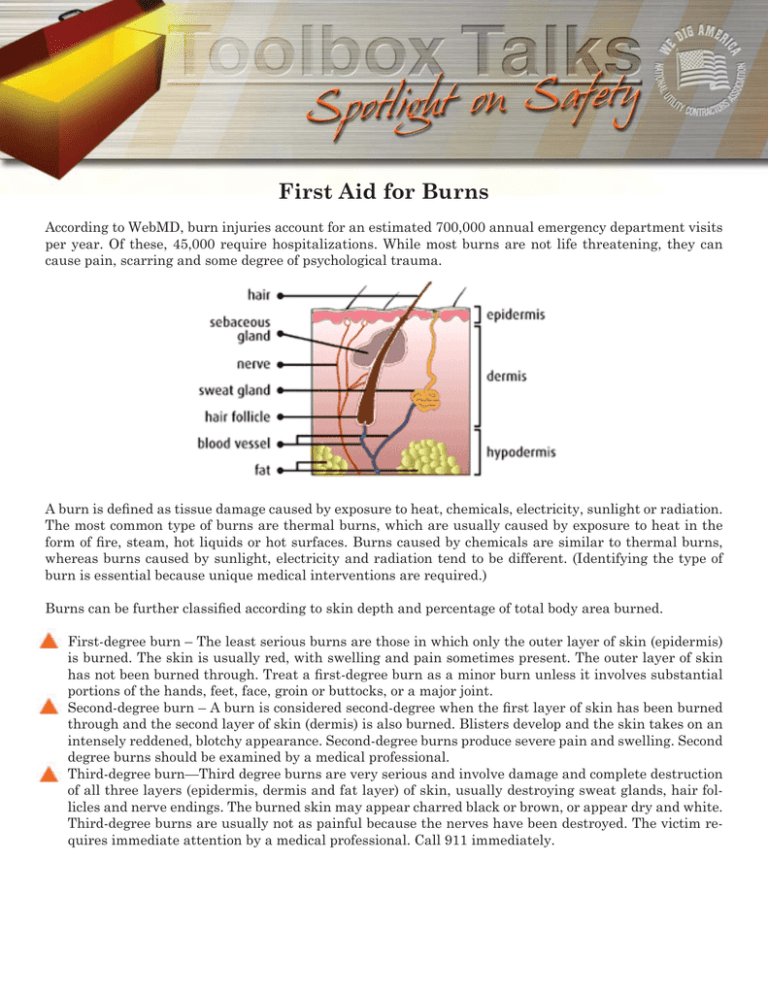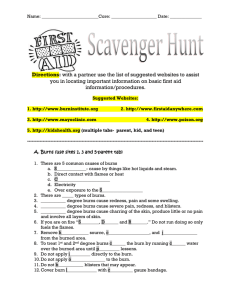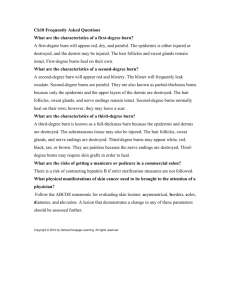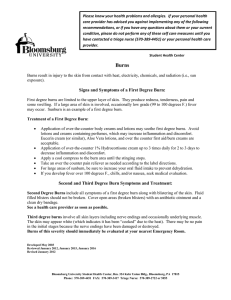
First Aid for Burns
According to WebMD, burn injuries account for an estimated 700,000 annual emergency department visits
per year. Of these, 45,000 require hospitalizations. While most burns are not life threatening, they can
cause pain, scarring and some degree of psychological trauma.
A burn is defined as tissue damage caused by exposure to heat, chemicals, electricity, sunlight or radiation.
The most common type of burns are thermal burns, which are usually caused by exposure to heat in the
form of fire, steam, hot liquids or hot surfaces. Burns caused by chemicals are similar to thermal burns,
whereas burns caused by sunlight, electricity and radiation tend to be different. (Identifying the type of
burn is essential because unique medical interventions are required.)
Burns can be further classified according to skin depth and percentage of total body area burned.
•
•
•
First-degree burn – The least serious burns are those in which only the outer layer of skin (epidermis)
is burned. The skin is usually red, with swelling and pain sometimes present. The outer layer of skin
has not been burned through. Treat a first-degree burn as a minor burn unless it involves substantial
portions of the hands, feet, face, groin or buttocks, or a major joint.
Second-degree burn – A burn is considered second-degree when the first layer of skin has been burned
through and the second layer of skin (dermis) is also burned. Blisters develop and the skin takes on an
intensely reddened, blotchy appearance. Second-degree burns produce severe pain and swelling. Second
degree burns should be examined by a medical professional.
Third-degree burn—Third degree burns are very serious and involve damage and complete destruction
of all three layers (epidermis, dermis and fat layer) of skin, usually destroying sweat glands, hair follicles and nerve endings. The burned skin may appear charred black or brown, or appear dry and white.
Third-degree burns are usually not as painful because the nerves have been destroyed. The victim requires immediate attention by a medical professional. Call 911 immediately.
First Aid for Burns
For minor burns, including second-degree burns limited to an area no larger than 2 to 3 inches in diameter, take the following actions:
• Cool the burn. Hold the burned area under clean, cold running water
for at least 5 minutes, or until the pain subsides. If this is impractical,
immerse the burn in clean, cold water or cool it with cold compresses.
Cooling the burn reduces swelling by conducting heat away from the
skin. Do not put ice on the burn because it can cause frostbite, further
damaging the skin.
• Cover the burn with a sterile gauze bandage. Bandage the area to stop
the chance of infection. Do not use fluffy cotton, which may irritate the
skin. Wrap the gauze loosely to avoid putting pressure on burned skin.
Bandaging keeps air off the burned skin, reduces pain and protects
blistered skin.
• Don’t break blisters. Blisters are the body’s way of retaining vital fluids around the burn. Broken blisters
increase the possibility of infection.
• Do not use butter or other ointments such as petroleum jelly (e.g., Vaseline).
• Avoid using local anesthetic sprays and creams. They can slow healing and may lead to allergic reactions in some people. Let a medical professional make that decision.
Third-degree burns require professional medical attention. Call 911. Until emergency personnel arrive,
follow these steps:
• Check for signs of circulation (breathing, coughing, or movement). If there
is no breathing or other sign of circulation, begin cardiopulmonary resuscitation (CPR). Treat the victim for shock (victim on back, elevate feet
and keep victim comfortable) if he/she does not have any broken bones or
head, neck or back injuries.
• Try to calm the victim.
• Cover the area of the burn. Use a cool, moist, sterile bandage a clean,
moist cloth or towel.
Here’s what you should not do:
• Don’t remove burnt clothing. However, do make sure the victim is no longer in contact with smoldering materials or exposed to smoke or heat.
• Don’t immerse large, severe large burns in cold water. Doing so can cause the victim to go into shock.
• Don’t apply any type of ointment, cream, butter or antiseptic sprays on the burn.
• Don’t give the victim anything to drink or eat.
Other things you can do to help a burn victim:
• Put out the fire. If a you or another person is on fire stop, drop and roll the victim on the ground to
smother the fire or put it out by covering the victim with a blanket or canvas tarp. Never use vinyl or
plastic materials because they will burn and melt.
• Turn off the power source if it is an electrical burn. Do not touch a victim until the power is disconnected.
• Rinse chemical burns down under an emergency shower or spray from a low pressure hose for at least
20 minutes.
• Call for a trained first aid person or provide basic first aid as described above.
• Call 911 immediately for seriously burned victims and victims who have been exposed to radiation.
And, remember that prevention is the best tool in the management of burn injuries!
Copyright©2006 by the National Utility Contractors Association—All rights reserved.
Disclaimer: This publication is designed to provide accurate and authoritative information in regard to the subject matter covered. However, the information in this toolbox talk is provided without any representation or warranty, express or implied, regarding its accuracy or correctness.





